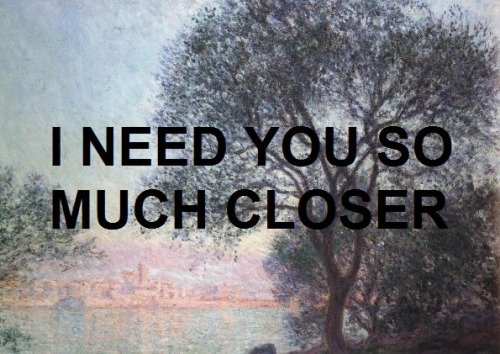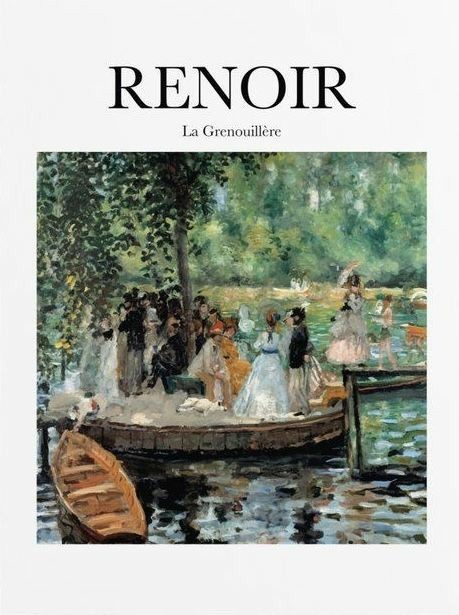Claude Monet - Blog Posts

The Willows, 1880, Claude Monet
https://www.wikiart.org/en/claude-monet/the-willows





Decided I felt like sharing some of my senior year art assignments. These are all over a year old but I still think they’re pretty neato.

A couple admires the color and texture of Monet’s Water Lilies at MoMA, New York

“i need you so much closer”
monet (impression, sunrise; 1892-1894) feat. death cab for cutie (transatlanticism)

Monet’s bicycle
iPhone collage
Photos of bicycle and hermit’s grotto my own







The Poet E.E. Cummings once described the moon as "the Lily of the Heavens". Our word Lily comes from the Greek word Lilium which could mean "Pure", the Greeks called the flower Leirion meaning "True". The painter, Claude Monet very famously painted a collection of over two hundred and fifty impressionist art pieces of water lilies, that specific genus is called Nymphaea, which has the root of the Greek word Nymph, meaning bride. Some now use that word in relation to beauty. A large portion of Monet's paintings were created after the death of his wife, during and/or post-world-war-two. And some of these paintings as well were composed while he had cataracts. The products of the clouded vision of his eyes. I have been lucky enough to witness some of the paintings myself, some here in Indy, while we had them on exhibit during Newfield's "Monet and Friends", or on their permeant exhibit in Chicago, or in Cleveland or where have you. I think it's something so beautiful that we get to interact with art on these levels where our human experience is so contextual and subjective. Just so particular to us as singular individuals. Like you probably will view George Hitchcock's Calypso in a totally different light than I will. I will see it as a piece of art depicting a woman, mourning and grieving the loss of her lover Odysseus. Longing, Pining, Loving. You might just see it as a painting of a sea nymph, a "water lily" one might say now that you know some other words. But art is also objective, and out-of-context sometimes too. Monet states in his own observation and intention of his works “it would produce the illusion of an endless whole, of water with no horizon and no shore”. That is to say like the reach of their intention is finite, but our interaction and interpretation of it is in-finite. It is not definite. An “Endless Whole”. You might know that I, as an individual, I don't view grief/love, joy/sorrow as separate things. They are the same coin, and they buy into this great experience called life. And in contradiction to that, they are probably not too dissimilar as well to “water with no horizon or shore”. Monet probably painted these painting and thought of his wife, Monet probably painted and thought of the war going on around him. E.E. Cummings probably wrote his poems at about or around the same time Monet was painting his collection. While also(!) George Hitchcock was painting "Calypso". Isn’t that beautiful? The Rendering of Associations. I'd like to call it. If we use some entomologic arguments here based off of what I’ve told you in this ‘dissertation’ (jokingly, basically), one might be able build off what Cummings wrote as "the Moon, the true pure beauty of the Heavens.”. Like what have I spent the last five-hundred-some-odd words writing about here. Painters and Paintings? Poetry? Love? Loss? Have I been writing this to the Moon, or is it to you maybe? Or this to one particular special person right now that I think about in my reflections of the moon, or flowers or water? These ‘Illusions’ as Monet might describe or in my case here an allusion of a seamless image. “The Rendering of Associations of The Endless Whole of Life.”






"One might take the tip of the pencil and magnify it. One reaches the point where a stunning realization strikes home: The pencil tip is not solid; it is composed of atoms which whirl and revolve like a trillion demon planets. What seems solid to us is actually only a loose net held together by gravity. Viewed at their actual size, the distances between these atoms might become league, gulfs, aeons. The atoms themselves are composed of nuclei and revolving protons and electrons. One may step down further to subatomic particles. And then to what? Tachyons? Nothing? Of course not. Everything in the universe denies nothing; to suggest an ending is the one absurdity."
- Stephen King, The Gunslinger
![Claude Monet The Flowered Arches At Giverny, 1913 Oil On Canvas Credit: The Athenaeum [Public Domain]](https://64.media.tumblr.com/53b5e250b1bdd837f59fcdfb4d3ef700/tumblr_pn4ss7tXcc1xu2jd9o1_500.jpg)
Claude Monet The Flowered Arches at Giverny, 1913 Oil on canvas Credit: The Athenaeum [Public Domain]
![Claude Monet Hamerocallis, 1914-1917 Oil On Canvas Credit: The Athenaeum [Public Domain]](https://64.media.tumblr.com/82511b3981bb552de1448730af63a887/tumblr_pm26wdm96Y1xu2jd9o1_500.jpg)
Claude Monet Hamerocallis, 1914-1917 Oil on canvas Credit: The Athenaeum [Public Domain]
![Claude Monet Wisteria, 1925 Oil On Canvas 153.6 X 203.5 Cm Credit: The Athenaeum [Public Domain]](https://64.media.tumblr.com/5c1227984a8c6f84284cd4d6811aa823/tumblr_plr8llgEdb1xu2jd9o1_500.jpg)
Claude Monet Wisteria, 1925 Oil on canvas 153.6 x 203.5 cm Credit: The Athenaeum [Public Domain]
![Claude Monet Agapanthus, Between 1914 And 1926 Oil On Canvas Credit: Wikimedia Commons [Public Domain]](https://64.media.tumblr.com/1972041534c50044e02fa30c35cf7025/tumblr_pkq96vMWGW1xu2jd9o1_500.jpg)
Claude Monet Agapanthus, between 1914 and 1926 Oil on canvas Credit: Wikimedia Commons [Public Domain]
![Claude Monet Flowers, 1860 - 1912 Oil On Panel 91 X 48 Cm Credit: Wikimedia Commons [Public Domain]](https://64.media.tumblr.com/e06b034fb11e870e07dec5a538128aa6/tumblr_pjp1b0Rx6y1xu2jd9o1_1280.jpg)
Claude Monet Flowers, 1860 - 1912 Oil on panel 91 x 48 cm Credit: Wikimedia Commons [Public Domain]
![Claude Monet Water Lilies, 1907 Oil On Canvas 73.5 X 92.5 Cm Credit: Wikimedia Commons [Public Domain]](https://64.media.tumblr.com/d03b04d30e52513c22e27a099a0f4493/tumblr_phuhz1EvqR1xu2jd9o1_500.jpg)
Claude Monet Water Lilies, 1907 Oil on canvas 73.5 x 92.5 cm Credit: Wikimedia Commons [Public Domain]

Claude Monet The Path through the Irises, 1914-17 Oil on canvas 200.3 x 180 cm Credit: The Walter H. and Leonore Annenberg Collection, Gift of Walter H. and Leonore Annenberg, 2001, Bequest of Walter H. Annenberg, 2002 | Metropolitan Museum of Art



The Water-Lily Pond by Claude Monet (1899)

Claude Monet, La Gare Saint-Lazare (Saint-Lazare Train Station), 1877, Musée d’Orsay, Paris.

Claude Monet, Soleil couchant sur la Seine à Lavacourt, effet d’hiver (Setting sun over the Seine at Lavacourt, winter effect), 1880, Petit Palais, Paris.

Claude Monet, Mount Kolsaas, 1895, Musée d’Orsay, Paris.

Claude Monet, La pie (the Magpie), 1868-69, musée d’Orsay.























